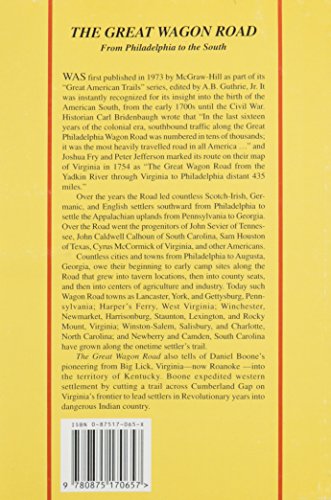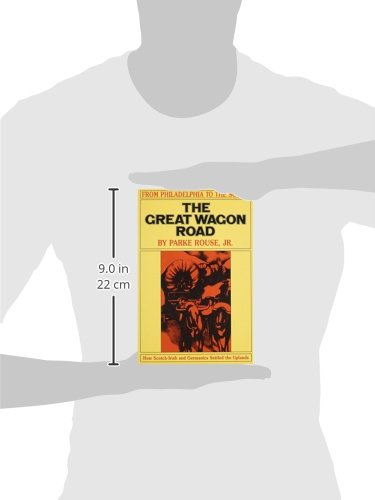



The Great Wagon Road: From Philadelphia to the South
C**N
History
History of migration from Pennsylvania to the South and beyond.My Hall ancestors migrated from PA to Orange County, NC, in about 1788. I thought this book would help me trace them. Alas, not many names are given, but I recommend this book to any person searching their ancestors.
M**D
America's First Great Migration!
This work is so poorly written, repeats itself and wanders away from its subject so often that it is more like a collage written by a high school student than a serious history. It is a cluttered hodgepodge. Yet it is an important work, one that should be read.It is only recently that I realized Philadelphia was to the continental colonies what Ellis Island was to the later United States. I wonder how many Southerners will be surprised to find out that their ancestors migrated from the North. While the concept is amusing in a wry sort of way, it also helps explain the developing sense of colonial identity. Those people up North or down South were not strangers. They were Aunt Mary, Cousin John, or Grandpa!The growth of Great Britain's American colonies was constrained by 2 facts of 16th and 17th century life: the Appalachian Mountains and King George II. It was a horrendous task to cross the mountains and their sovereign forbid it. Founded on religious freedom, Pennsylvania became a haven for all sorts of people fleeing Europe. So for years, as population concentrations grew in and around Philadelphia, and because westward migration was out of the question, a natural migration southward occurred along an ancient Indian trading and warring path which connected the entire northern and southern east coast.This path was acquired from the Indians over time and became known as The Great Wagon Road, so labeled on a map drawn by Thomas Jefferson's father, Peter. It is over this settlers' path from Philadelphia that the western portions of Virginia, North and South Carolina and Georgia were originally peopled. This migration was vast, lasting 50 to 60 years and numbering in the tens of thousands of people. And many of the original overnight camping spots grew to become American cities such as Winston-Salem, Augusta, Winchester and Gettysburg to name a few. After the American Revolution this flood tide turned westward into Tennessee and Kentucky along Daniel Boone's Wilderness Road.This is the story of an almost unreported mass migration that occurred during Britain's colonial period, a movement that peopled major portions of what was to become the United States. Quietly, very quietly, the record shows that we really were one people long before the American Revolution occurred.
F**R
Vivid detail about life along the great wagon road
After researching my family tree, I found it interesting that for several branches generation after generation were going from Ireland to Pennsylvania, Virginia, North Carolina, Tennessee, Kentucky, then strangely up to Indiana and Illinois. Other branches of my family tree took the National Road west, but the Great Wagon Road is an interesting story for the development of the early eastern United States. It was a road "worn down in earlier ages by buffalo." Later after the extinction of the eastern buffalo it was "the ancient Warrior's Path...used by Iroquois tribesmen of the north to come south and trade or make war in [what later would become] Virginia and the Carolinas."While much has been written about the Scots-Irish, this book includes other Protestant migrants such as the German, Moravian, Palatine, and Quakers. The book also describes the various Protestant preachers such as Francis Asbury and Peter Muhlenberg that so affected the settlers, broadly cast the seeds of religious freedom and anti-slavery. Many of those clans who migrated to North Carolina, moved onto Tennessee and Kentucky only to find that they could not compete economically with slaveholders and moved north to the free labor states of Ohio, Indiana, and Illinois. There they met other branches who generally followed the National Road west from Philadelphia.The book is full of details that give the reader clear pictures of what life was like living along the great wagon road and various branches west. I recommend the book for those wanting an in-depth image of what their ancestors did to survive and make a life for themselves in this part of the country.
R**N
Good early American History
In early American history this is how people moved up and down and into the west. You can see some remains of this road today.I was interested in this book because I had a Very Grandmother go from Greencastle Penn area to Ausgusta Co. Va in the 1760s. I also have traveled on some of new road which has replaced the old dirt road. It told me what my Grandmother would have seen on her trip.
D**A
Informative, interesting and entertaining
This is an interesting and informative book, not so much giving specifics about how/when different groups migrated where, but giving a very good idea of what a central role the Great Wagon Road played. Its role in migration I had always understood, but its significance during the Revolutionary War was something I had never given much thought to. I especially appreciated the first-hand accounts from diaries and such - you can talk in the abstract about the way things were, but there's no substitute for hearing a version from someone who lived it. I always loved reading about the Old Waggoner, Daniel Morgan, but fell in love with this no-nonsense tough guy all over again from reading about his exploits vis-à-vis this road as both civilian and military commander. His character sounds very much like one of my own ancestors who grew up on the frontiers of Georgia.
C**X
As a Genealogist, I LOVE THIS BOOK!
I love this book. It really gives the reader an idea of what it was like for our ancestors to survive the elements, to do business, to migrate down the great wagon road. It takes you through time and helps us understand how America began and the struggles our ancestors made to settle the new world. Love it!
Trustpilot
3 weeks ago
1 month ago